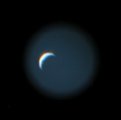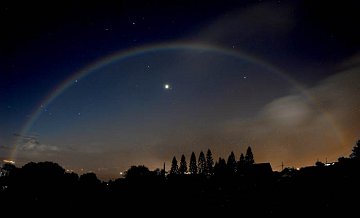 Would you like a call when the space station flys over your home town? Sign up for Spaceweather PHONE.
Would you like a call when the space station flys over your home town? Sign up for Spaceweather PHONE.
SPACE STATION ECLIPSE: On May 13th, sky watchers can see a total eclipse of the planet Jupiter by the International Space Station (ISS). The narrow path of totality runs up and down the US east coast. If you miss the eclipse, you can still see the ISS during one of its many bright evening apparitions this week. Get the full story from Science@NASA.
SUNSPOT WATCH: Sunspot group 609 was practically invisible yesterday; today it's wider than Earth and visible from a distance of 93 million miles. The fast-growing 'spot and its unstable magnetic field pose a threat for M-class solar flares.

Above: Spanning a 30-hour period beginning 00:00 GMT on May 12th, this sequence of SOHO images shows the development of sunspot group 609. Individual spots within the group are each about the size of Earth.
COMET NEAT: Comet NEAT (C/2001 Q4) is fading, but it's still an easy target for binoculars and backyard telescopes. Look for it tonight after sunset; it's not far above the bright star Procyon in the southwestern sky. [sky map] [ephemeris]
 CRESCENT VENUS: If you have a telescope, even a small one, point it at Venus. The planet, which has phases like the Moon, looks like a slender silvery crescent. Beautiful! You can find Venus shining brightly in the western sky at sunset. Venus is nearing Earth, so the crescent will grow larger and thinner every night for the rest of this month.
CRESCENT VENUS: If you have a telescope, even a small one, point it at Venus. The planet, which has phases like the Moon, looks like a slender silvery crescent. Beautiful! You can find Venus shining brightly in the western sky at sunset. Venus is nearing Earth, so the crescent will grow larger and thinner every night for the rest of this month.
Right: Venus seen through a 4.5-inch telescope. "I would recommend everyone to go outside now and have a look, Venus is magnificent," says photographer Eric Walker of Scotland.
MOONBOW & VENUS: We've all seen rainbows during the day, but what about a rainbow at night? Rob Ratkowski of Pukalani, Maui, photographed this one soaring over the planet Venus on May 4th:

This is a lunar rainbow, or moonbow, caused by beams of moonlight bent by water droplets suspended in a mist over Maui's pineapple fields. "I got two phone calls from neighbors at 10:30 p.m. telling me to look," says Ratkowski. Moonbows are typically pale, and "there was only a slight amount of color visible to the unaided eye." But the camera revealed the colors nicely.

